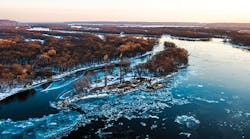The first European to cross the Mississippi River was Spanish explorer Hernando de Soto by boat in 1541, and then railroads crossed it in 1856. But navigating the river has never been easy, even today.
Workers just finished a CapX2020 345/161/69-kV transmission line spanning 1.3 miles (2 km) over the Mississippi River near Kellogg, Minnesota, and Alma, Wisconsin. It is part of the 150-mile (241 km) Hampton–Rochester–La Crosse transmission line project. The completion was a feat for professionals who used creativity, skill and determination to overcome the challenges of the river crossing.
A Joint Initiative
The work is part of CapX2020, a joint initiative of 11 transmission-owning utilities in Minnesota, North Dakota, South Dakota and Wisconsin. The initiative was formed to upgrade and expand the electric transmission grid to ensure continued reliable and affordable service, and to meet state and regional energy policy goals, including renewable energy mandates.
The CapX2020 projects include four 345-kV transmission lines and a 230-kV line. The lines are projected to cost more than US$2 billion and cover a distance of nearly 800 miles (1290 km). Xcel Energy is the managing partner on the $500 million Hampton–Rochester–La Crosse project, which also includes Dairyland Power Cooperative, Rochester Public Utilities, Southern Minnesota Municipal Power Agency and WPPI Energy.
The 345-kV line provides an electrical upgrade to a remote area known for its beauty. The Mississippi River cuts through wooded rolling hills on both sides and is home to a national wildlife refuge and an important flyway for migratory birds. Therefore, careful consideration had to be given to every step of the project.
Permitting and Site Selection
Getting regulatory permission to cross the Mississippi was a critical hurdle of the project. The river bluffs and rough terrain were also factors in finding the right spot to span the Mississippi. Ten regulatory agencies and the public were heavily engaged in site selection. The U.S. Fish & Wildlife Service (FWS), U.S. Army Corps of Engineers and U.S. Rural Utilities Service represented the federal government. Minnesota’s Public Utilities Commission and Wisconsin’s Public Service Commission issued the permits, but both states’ departments of transportation, natural resources and historic preservation offices also weighed in on the project.
The CapX2020 team made nearly 50 presentations to local governments and interested stakeholders, and hosted or participated in 64 public meetings and hearings.
“There were a lot of times we didn’t know the path forward,” said Tom Hillstrom, the Xcel Energy permitting manager. “It was not just about the river, and it was not just about the refuge, it was about getting to the river from both sides.”
La Crescent and Winona, Minnesota, as well as Alma, Wisconsin, were frontrunners of the crossing site in 2008 because all three locations had existing power lines and rights-of-way, minimizing the construction’s impact. The narrowest place to cross the Mississippi River was Alma. Additionally, project partner Dairyland Power Cooperative, which owned the existing 161/69-kV line at the Alma crossing and a coal plant on the Wisconsin side of the river, had property adjacent to the line and the federal refuge, which also made it desirable.
“There was a lot of listening to people. There was a good process. In the end, the process picks the route with the least impact,” said Hillstrom.
It took three years to select Alma and two more years to complete the permitting process, resulting in a unique partnership requiring both collaboration and negotiation. “We were with them every step of the way,” said Mary Stefanski, the Winona district manager of the FWS.
The agency in charge of the world-premiere migratory corridor and wetland of international importance focused on the project’s environmental impact. The agency wanted safety for the hundreds of thousands of birds traveling through the area each season as well as protection of a mature forest filled with silver maples and cottonwood trees, some up to 75 years old.
FWS requirements were factored in designing the structures at the river crossing. Four design alternatives were created. Ultimately, the FWS accepted a design that kept tower heights below 200 ft (61 m) to avoid the need for aviation lighting, arranged the conductors in a horizontal plane and included bird diverters on the shielded wires; all are accepted practices to reduce the likelihood of bird strikes. The existing double-circuit line was removed and rebuilt to this same configuration. The result is an improvement to the protection of birds along the flyway.
Construction Challenges
This was a unique challenge for Xcel Energy as the construction lead on the project. Todd Obermoeller of Power Engineers worked with Xcel Energy for several months to develop an overhead line design that met FWS needs (towers less than 200 ft tall) along with the U.S. Army Corps of Engineers requirement for the conductors to be 90 ft (27 m) above water, allowing barge traffic and taller boats to navigate the shipping channel. These refinements also resulted in the elimination of two structures from the original design, which saved the project approximately $2 million.
Experts at building transmission towers on land, the utility now needed professionals who understood the ebb and flow of the Mississippi River, where water levels fluctuate up to 15 ft (4.6 m), depending on the season. “We brought our river experience and our bridge foundation experience to the project,” said Steve McCaskie, an engineer with Hanson Professional Services.
The bridge experts focused on the five transmission towers that would span the Mississippi River channel and flood plain. Water currents can wash away soil around the foundation, jeopardizing its stability. Also unique to the river environment are the effects of ice, floods and winds that impact the design. Engineers developed a concrete and steel foundation — with the largest at 36 ft wide by 80 ft long (11 m by 24 m) — to be anchored by steel piles driven up to 160 ft (48.8-m) deep in the river. “The design and risk management decisions Xcel Energy made will result in a successful river crossing for years to come,” said McCaskie.
Construction crews dealt with other obstacles. Even after years of planning, workers faced supply shortages and unpredictable weather. The first task was dismantling the original double-circuit line built in 1955. Then the concrete and steel foundations were built for the five towers carrying the new line across the river. Two of the towers, one on an island and the other on a peninsula, could only be reached by barge. “Access was the No. 1 challenge,” said Zach Pontzer of J.F. Brennan Co., the foundation construction company on the project.
Shuttling 50 construction workers, their equipment and supplies to each location required careful coordination. They overcame each difficulty, even delivering 95 concrete trucks, by barge, in one day. J.F. Brennan never ran out of concrete or skilled iron workers, even though both were in short supply because of a construction boom in the Twin Cities, including the building of the Minnesota Vikings stadium in Minneapolis.
Work Underway
Construction on the river crossing started in August 2014, when water levels tend to be lowest. But heavy rain caused high water levels, resulting in multiple construction delays and even forced a brief closure of the shipping channels. Then cold weather arrived, causing the Mississippi to freeze early in November.
“The river is an adventure every day. It’s always changing. But we felt like we couldn’t catch a break,” said Pontzer. Some wondered when the locusts and frogs would arrive. Joking about the biblical plagues eased tensions for a team dodging ice chunks and enduring below-zero temperatures while working under a tight timeline.
The FWS extended work permits past the original December 2014 deadline because of the weather delays, but the bald eagle’s breeding season would really determine the end of construction. There are 270 active eagles’ nests on the refuge, and the bald eagle can return any time after the first of the year. While only one eagle’s nest impacted construction, the workers gave it wide berth. The agency required a 660-ft (200-m) buffer zone around the nest at all times. “We have been very strict; we won’t let anyone disturb an eagle nest during their breeding season,” said Stefanski. In January 2015, she asked the team to change construction methods. Workers stopped using helicopters to install certain equipment and used carts instead.
Project Completion
Xcel Energy overhead line crews, led by general foreman Keith Legatt, fought winter weather to install poles and conductors. This two-month process was completed Feb. 4, 2015. All who played a role in the project have a new appreciation for the power and beauty of the Mississippi River and the expertise needed to accomplish the Hampton–Rochester–La Crosse river crossing. The team spent the last eight years focused on creating a link that provides better service for people while protecting a national gem filled with wildlife.
Grant Stevenson has been employed by Xcel Energy for 31 years and is project manager for the CapX2020 Hampton–Rochester–La Crosse project. Stevenson has worked on the 150-mile interstate 345-kV project since 2006, including project formation, state and federal permitting, design and construction. Stevenson has extensive experience managing complex, multimillion-dollar high-voltage transmission projects.
Xcel Energy | www.xcelenergy.com
Sidebar: Project by the Numbers
- The estimated crossing length is 1.3 miles (2 km).
- The estimated crossing cost was $20 million.
- There are five structure sets that total 15 pile cap foundations.
- A structure location on the Wisconsin side of the river sits on an island and a structure location in Minnesota sits on a peninsula.
- Foundations were supported with 362 16-inch (406-mm)-diameter pipe piles, driven deep into the soil at 60 ft to 160 ft (18 m to 49 m); many foundations have 30 or more pipe piles.
- The total length of the steel pipe pile is more than 25,000 linear ft, or 6 miles (10 km).
- The crossing used 3280 cu yd (2507 cu m) of concrete, or 328 truckloads.
- More than 150 loads of concrete were delivered to the island and peninsula by taking trucks onto barges.
Sidebar: Permits Required
Minnesota
- Certificate of Need and Route Permit, Minnesota Public Utilities Commission
- License to cross public waters, which included a request to construct a rock barge landing in the Mississippi River for access to the peninsula between the Zumbro and Mississippi Rivers
- Construction Environmental Control Plan (CECP) describing and showing construction impacts and access for river crossing construction
Wisconsin
- Certificate of Public Convenience and Necessity, Wisconsin Public Service Commission
- Amendment to the Chapter 30 waterways and wetlands permit allowing for construction of a rock barge landing on the island
- CECP describing and showing construction and access to river crossing structures
- Development exemption for construction of a structure within the ash landfill at the Dairyland Power Cooperative plant
Federal
- Special-use permits for tree clearing and construction on Upper Mississippi Fish & Wild Life refuge land
- Mitigation for the clearing of forested refuge wetlands
- Amendment to the Corps of Engineers Section 404 and Section 10 permit to allow construction of rock barge landings on the Mississippi River
- U.S. Coast Guard notice to Mariners regarding project-related barge traffic







